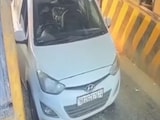The Delhi Red Fort car blast used an (as yet) unspecified amount of ANFO, an explosive compound containing ammonium nitrate and fuel oil, packed into a Hyundai i20. The bomb was set off by a detonator that may have been manually triggered, which makes it a suicide attack.
An estimated 350 kg of ammonium nitrate was recovered by Jammu and Kashmir Police Sunday during raids on two residences linked to a Dr Mujammil Shakeel, who worked at the Al-Falah Hospital in Haryana's Faridabad. Intelligence sources told NDTV Shakeel and his accomplices – Dr Adil Ahmed Rather and Dr Shahina Shaheed – were part of a Jaish-e-Mohammed terror cell that infiltrated India.
The Faridabad raids – which, it now appears, led a panicked fourth member, Dr Umar Mohammed. into triggering the Red Fort car bomb – also yielded more than 2,000 kg of other explosive material.
When the raids were confirmed Monday morning, initial reports said the material recovered was RDX, which set alarm bells ringing in the government and intelligence communities.
However, as it turned out, the recovered substance was ammonium nitrate.
So, what is the difference?
What is RDX?
It is a single, high-explosive chemical.
In simple terms, an extremely powerful, compact military-grade explosive first used during World War II; the British used it against German U-boats that had thicker-than-normal hulls.
The Germans actually discovered the compound earlier, during the first World War, but did not use it because of the expensive production process. Eventually, though, they too began using it; explosive shells fired by weapons mounted on its fighter jets used RDX (they called it hexogen).
Today, it is recognised as a white and odourless organic compound – chemical formula CH2N2O2 – and the key ingredient in other powerful explosives, including C-4 and Semtex.
Chemical formula for RDX. Source: WIkipedia
RDX is classified as a high-brisance charge, meaning it can shatter and fragment steel, concrete, and other very hard structures. Basically it refers to the detonation velocity of an explosive, i.e., the speed at which they explode, making the resulting shock waves more potent.
RDX has one of the highest brisance figures among conventional explosives – up to 8,700 metres per second and a relative effectiveness, or RE, factor of 1.5 to 1.6.
For comparison, the RE factor of TNT, a baseline explosive, is 1.0.
That means RDX is at least 50 per cent more powerful than TNT.
The RE of ANFO that was in the Delhi Red Fort car bomb is around 0.75.
Links emerge between Red Fort car bomb and Pak-based terror group Jaish-e-Mohammed
Understandably, initial reports of the recovery of 350kg of RDX were met with alarm.
RDX – or C-4, Semtex, or substances containing RDX – have been used in terror strikes worldwide, including by the Provisional IRA, or Irish Republic Army, in Northern Ireland and Britain, in the 1980s and 1990s. In that case the PIRA received Semtex from foreign suppliers.
Ammonium Nitrate
In simple terms it is a salt consisting of one ion each of ammonium and nitrate that is formed by the reaction of ammonia (NH3) and nitric acid (HNO3), which gives it the formula NH4NO3.
It is an odourless, white crystalline chemical that is widely used as a fertiliser but is also a powerful oxidiser that, under the right conditions, can cause a powerful explosion resulting in fires that burn at high temperatures for sustained periods.
Chemical formula for ammonium nitrate. Source: Wikipedia
Importantly, unlike RDX, by itself it is not considered an explosive.
It needs to be mixed with a secondary substance – in the Red Fort bomb that was fuel oil, a petroleum-based product – and triggered by an external detonation to explode.
NDTV Spotlight | Ammonium Nitrate Fuel Oil Found In Delhi Red Fort Blast. What Is It?
In fact, it can be mixed with almost any kind of volatile substance. But the quality is important; pure NH4NO3 is chemically and thermally stable, meaning it requires that external detonation. And a stronger initial blast is more likely to result in a larger and more stable explosion.
Nevertheless, it will still be a lower-yield explosive because of lower output per kilogram.
Its destructive power, therefore, comes from sheer volume rather than brisance, which is why large ANFO-based bombs – such as the one used in Oklahoma City in 1995 – can weigh hundreds and even thousands of kilograms.
NDTV Spotlight | J&K Doctor With Ammonium Nitrate Arrested. How Dangerous Is It?
Ammonium nitrate is a controlled substance in India; sale and possession is supposed to be monitored under rules framed in 2012 (and amended in 2021). As a result, manufacture, storage, and use requires licences from the Petroleum and Explosives Safety Organisation.
Unauthorised individuals cannot purchase or possess ANFO.
How the terrorists managed to secure such large quantities of ammonium nitrate and other explosive substances used is one of the biggest, if not the biggest, question investigators need to answer.
NDTV is now available on WhatsApp channels. Click on the link to get all the latest updates from NDTV on your chat.















